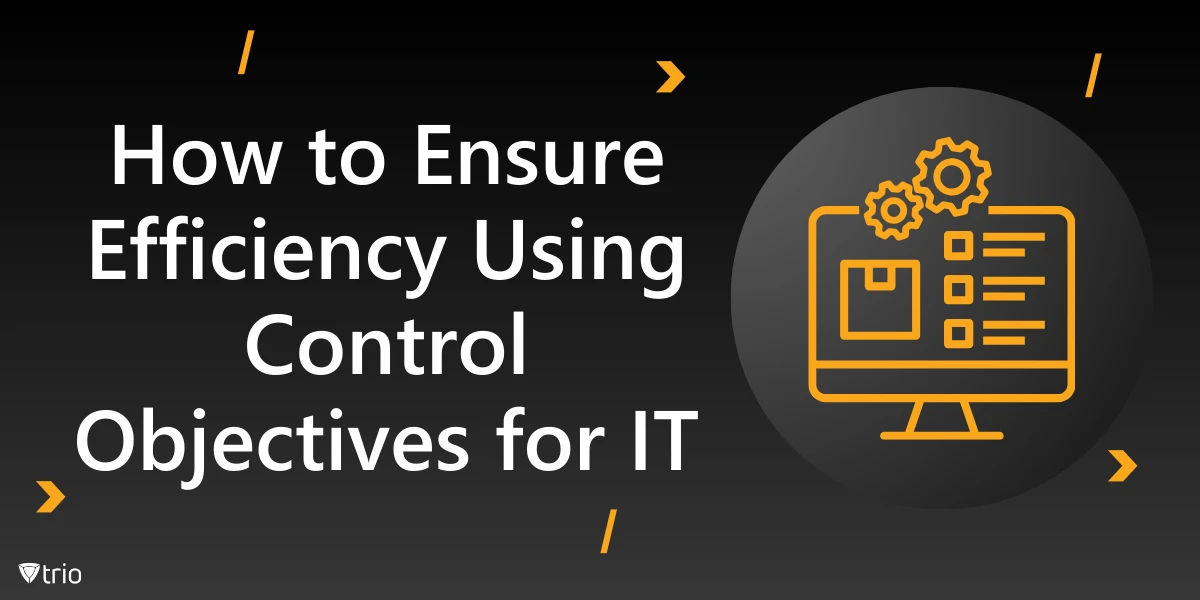In the realm of IT, effective governance and management of resources are essential for organizational success. Control objectives provide a structured framework for organizations to ensure IT processes align with business goals, secure critical assets, and comply with regulatory standards. This blog explores the concept of control objectives in IT, their significance, types, and best practices to help businesses establish a sound governance framework that boosts resilience, efficiency, and accountability.
What Are Control Objectives in Information Technology (IT)?
The meaning of control objectives in IT are specific goals set to direct, manage, and monitor the activities of an organization’s IT infrastructure. By aligning IT processes with organizational needs and regulatory requirements, these control objectives act as guiding principles to safeguard the integrity, availability, and confidentiality of information. Control objectives not only support security and risk management but also help IT governance by allowing organizations to streamline operations and ensure regulatory compliance. The primary purpose of control objectives for an IT framework is to:
- Minimize risks associated with IT processes and infrastructure.
- Ensure compliance with regulatory frameworks and standards.
- Optimize IT resource management and support business goals.
For organizations that rely heavily on IT infrastructure, implementing objectives of IT security control is crucial for risk reduction and continuous improvement. Frameworks like COBIT (Control Objectives for Information and Related Technologies), ISO/IEC 27001, and NIST (National Institute of Standards and Technology) provide structured sets of control objectives for IT governance.
Why Control Objectives Matter in IT
Control objectives play a crucial role in an organization’s IT management strategy by providing a foundation for effective risk management, streamlined operations, and compliance. Here’s why they matter:
- Improved Security Posture: Control objectives ensure IT systems are secure, helping prevent data breaches, unauthorized access, and cyberattacks.
- Operational Efficiency: They provide a roadmap for efficient processes, which can lead to better resource utilization and reduced downtime.
- Compliance and Auditing: Adhering to control objectives helps organizations comply with industry standards and regulatory requirements, making it easier to pass audits.
- Alignment with Business Goals: Control objectives align IT services and processes with the organization’s goals, creating a more cohesive and integrated strategy.
Types of Control Objectives in IT
Control objectives are classified into several categories, each focusing on distinct aspects of IT governance and security. Control objective IT example types include:
1. Access Control Objectives
Access control objectives regulate user access to information and resources. Key elements include:
- User Authentication and Authorization: Ensuring users are verified and have permissions appropriate for their roles.
- Role-Based Access Control (RBAC): Assigning access based on the roles within an organization.
- Monitoring and Auditing: Tracking access logs to detect unauthorized access and compliance breaches.
2. Data Integrity and Confidentiality Objectives
Data-related control objectives focus on maintaining data security, integrity, and confidentiality. This helps with IT compliance strategies. It includes:
- Data Encryption: Protecting data in transit and at rest to prevent unauthorized access.
- Data Classification: Categorizing data based on sensitivity and applying relevant security controls.
- Regular Backups: Ensuring data recovery options are available in case of data loss or corruption.
3. Change Management Objectives
Change management control objectives minimize risks associated with updates, patches, and other changes to the IT environment. Key elements of these objectives are part of an IT asset management strategy and include:
- Documenting Changes: Keeping a record of all modifications to systems.
- Change Approval Process: Ensuring changes are approved by relevant stakeholders before implementation.
- Testing and Evaluation: Evaluating changes in a controlled environment before deployment.
4. Incident Response Objectives
These objectives outline procedures for identifying, responding to, and recovering from IT incidents. Incident response control objectives include:
- Incident Detection: Implementing systems to monitor and detect anomalies.
- Escalation Procedures: Defining steps to escalate incidents to appropriate levels.
- Post-Incident Analysis: Reviewing incidents to prevent recurrence.
5. Compliance and Regulatory Objectives
Compliance control objectives ensure that IT practices adhere to legal, regulatory, and industry standards. Key elements involve:
- Policy and Documentation: Establishing policies to support compliance with frameworks like GDPR, HIPAA, and PCI-DSS.
- Audit Readiness: Preparing systems and documentation for regular audits.
- Monitoring and Reporting: Continuously monitoring systems and reporting to maintain compliance.
6. Performance and Availability Objectives
These control objectives ensure that IT systems perform efficiently and remain available to users. Common objectives include:
- Uptime Monitoring: Tracking system uptime and quickly addressing downtime.
- Capacity Planning: Ensuring resources meet demand and adapting as necessary.
- Performance Optimization: Regularly assessing system performance and addressing bottlenecks.

Key Frameworks for IT Control Objectives
Several frameworks provide guidance on IT control objectives, helping organizations implement best practices and measure progress. Some widely recognized frameworks include:
1. COBIT (Control Objectives for Information and Related Technology)
COBIT is an IT governance framework that focuses on managing and optimizing IT processes to support business objectives. COBIT helps organizations establish, measure, and improve control objectives across several domains, including:
- Information Security
- Risk Management
- Compliance
- IT Strategy Alignment
2. ISO/IEC 27001
ISO/IEC 27001 is an internationally recognized standard for managing information security. It provides guidelines for developing control objectives and practices for data protection, access control, and incident management. Key components include:
- Asset Management
- Physical and Environmental Security
- Communications Security
3. NIST (National Institute of Standards and Technology)
NIST offers a comprehensive framework for risk management in IT environments, including detailed guidance on control objectives for cybersecurity. The NIST framework includes:
- Identify and Assess Risks
- Detect and Respond to Threats
- Recover from Incidents
4. ITIL (Information Technology Infrastructure Library)
ITIL provides a structured approach to IT service management, covering best practices for implementing control objectives in IT environments. Key areas include:
- Service Strategy
- Service Design
- Service Operation
Best Practices for Implementing IT Control Objectives
To successfully implement control objectives, organizations should consider these best practices:
1. Align with Business Goals
Ensure control objectives support broader organizational objectives. This includes identifying key business needs and aligning IT controls to meet those demands.
2. Regularly Update Controls
Regularly review and update control objectives to adapt to evolving risks, regulatory changes, and technological advancements.
3. Monitor and Measure Progress
Use metrics to measure the effectiveness of control objectives. Tracking KPIs, such as incident response time, can provide insight into areas that require improvement.
4. Involve Key Stakeholders
Include stakeholders from various departments in the development of control objectives to ensure organization-wide alignment and support.
5. Train Employees
Regular training ensures employees understand the importance of control objectives and can follow policies effectively.
Control Objectives Checklist for IT Teams
For IT teams, following a checklist can simplify the implementation and monitoring of control objectives. Here’s a checklist for establishing effective control objectives:
- Define Access Controls: Implement role-based access control and monitor for unauthorized access.
- Establish Data Protection Policies: Encrypt sensitive data and conduct regular backups.
- Develop Incident Response Plans: Create and regularly update procedures for incident detection and escalation.
- Monitor Compliance Standards: Review regulations relevant to your industry and ensure adherence.
- Review Change Management Protocols: Maintain documentation for all IT changes and implement an approval process.
- Optimize Performance: Conduct regular performance audits and ensure systems meet demand.
Conclusion
Control objectives in IT provide a structured approach to aligning IT practices with organizational goals, reducing risks, and ensuring compliance. Frameworks like COBIT, ISO 27001, NIST, and ITIL offer invaluable guidance, helping organizations create control objectives that support security, efficiency, and operational excellence. By following best practices and regularly reviewing control objectives, organizations can effectively manage IT resources, protect sensitive data, and adapt to an ever-evolving digital landscape.
Ensure that your IT control objectives align with your organization’s security and compliance goals by leveraging Trio’s Mobile Device Management solution. Take control of your IT governance strategy today—explore Trio’s free demo to see how we can help secure your IT environment efficiently and effectively.
Get Ahead of the Curve
Every organization today needs a solution to automate time-consuming tasks and strengthen security.
Without the right tools, manual processes drain resources and leave gaps in protection. Trio MDM is designed to solve this problem, automating key tasks, boosting security, and ensuring compliance with ease.
Don't let inefficiencies hold you back. Learn how Trio MDM can revolutionize your IT operations or request a free trial today!




